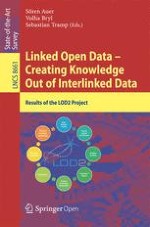1 Introduction
2 The LOD2 Linked Data Stack
2.1 Building a Linked Data Application
2.2 Becoming LOD2 Linked Data Stack Component
-
Information is exchanged in RDF format
-
Business information is requested through SPARQL endpoint access
-
Updates are provided as SPARQL updates
2.3 LOD2 Stack Repository
-
The developers’ area: here the developers put their packages.
-
The testing stage: this is a collection of LOD2 packages that are subject to integration tests. The goal is to detect with automatic testing problems in the installation of the packages.
-
The stable stage: this is a collection of LOD2 packages that pass the tests.
-
software components which are only accessible online due to various reasons: special setup, license rules, etc. Examples are the Sindice search engine and PoolParty.
-
information sources: for example dbpedia.org and vocabulary.wolterskluwer.de.
2.4 Installing the LOD2 Linked Data Stack
2.5 The LOD2 Linked Data Stack Release
2.5.1 Available as Debian Packages
2.5.2 Available as Online Component
2.5.3 Available Online Data Sources
URL | SparqlEndpoint |
|---|---|
Sindice (DERI, OGL)
| |
CKAN Repositories (OKFN)
| |
Dbpedia (ULEI, SWC, OGL)
| |
LODcloud (OGL)
| |
WebDataCommons RDFa, Microdata and Microformat data sets (UMA)
| |
German Courts and Labor Law taxonomies (WKD, SWC)
| |
2.5.4 The LOD2 Stack Components Functional Areas Coverage
3 A Customized Linked Data Stack for Statistics
-
efficient transformation/conversion of traditional data stores (e.g. CSV, XML, relational databases) into linked, machine readable formats;
-
building and querying triple stores containing RDF Data Cubes;
-
validating RDF Data Cubes;
-
interlinking and adding meaning to data;
-
visualization and exploration of multi-dimensional RDF Data Cubes;
-
publishing statistical data using a LOD publication strategy and respective metadata about the RDF data cube within a selected portal (i.e. a CKAN instance).
Scenario | Benefits/expected added value |
|---|---|
Goal:
Metadata management
| |
Code lists - creating and maintaining | Standardization on the metadata level: |
(a) will allow harmonization of specific concepts and terminology, | |
(b) will improve interoperability and | |
(c) will support multilinguality in statistical information systems across Europe | |
Goal:
Export
| |
Export to different formats | Data exchange with other semantic tools, as well as other commonly used spreadsheet tool e.g. Microsoft Excel |
Goal: RDF Data Cube - Extraction, Validation and Initial Exploration
| |
Standardization of the extraction process | |
(a) CSV Data Extraction | CSV2DataCube |
(b) XML Data Extraction | XML2DataCube |
(c) SDMX-ML 2 RDF/XML | SDMX2RDFDataCube |
Goal: RDF Data Cube Quality Assessment (validation and analysis of integrity constraints)
| |
Building well-formed RDF Data Cubes, where statistical data has been assigned an unique URI, meaning and links to similar data. This approach facilitates search and enables re-use of public statistical data | The well-formed RDF Data Cubes satisfy a number of integrity constraints and contain metadata thus enabling automation of different operations (exchange, linking, exploration) |
Goal: RDF Data Cube - Transformation, Exploratory Analysis and Visualization
| |
(a) Merging RDF Data Cubes | Data fusion i.e. creation of a single dataset and different graphical charts that supports the exploratory analysis (e.g. indicator comparison) |
(b) Slicing RDF Data Cubes | Facilitate creation of intersections in multidimensional data |
(c) Visualization of RDF Data Cubes | Efficient analysis and search for trends in statistical data |
Goal:
Interlinking
| |
(a) Code lists - Interlinking | Assigning meaning, improved interoperability of data with similar governmental agencies |
(b) CSV Data Extraction and Reconciliation with DBpedia | Assigning meaning |
Goal:
Publishing
| |
Publishing to CKAN | Increased transparency, improved accessibility of statistical data |
3.1 Application Architecture and Scenarios
3.2 LOD2 Statistical Workbench in Use
3.2.1 The RDF Data Cube Vocabulary
Component property | Concept description | Identifier | Code list |
|---|---|---|---|
Dimension | Geographical region | rs:geo | cl:geo |
Dimension | Time | rs:time | cl:time |
Dimension | Economic activity | rs:activityNACEr2 | cl:nace_rev2 |
Attribute | Unit of measurement | sdmx-attribute:unitMeasure | cl:esa95-unit |
Measure | Observed value | sdmx-measure:obsValue |
